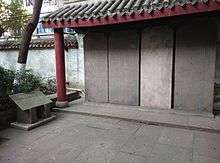Yu Dayou
| Yu Dayou | |
|---|---|
| General of the Ming dynasty | |
| Born | 1503 |
| Died | 1579 (aged 75–76) |
| Names | |
| Traditional Chinese | 俞大猷 |
| Simplified Chinese | 俞大猷 |
| Pinyin | Yú Dàyóu |
| Wade–Giles | Yü Ta-yu |
| Courtesy name | Zhifu (simplified Chinese: 志辅; traditional Chinese: 志輔; pinyin: Zhìfǔ; Wade–Giles: Chih-fu) |
| Posthumous name | Wuxiang (Chinese: 武襄; pinyin: Wǔxiāng; Wade–Giles: Wu-hsiang) |
| Other names | Xujiang (simplified Chinese: 虚江; traditional Chinese: 虛江; pinyin: Xūjiāng; Wade–Giles: Hsu-chiang) (art name) |
Yu Dayou (1503–1579), courtesy name Zhifu, art name Xujiang, was a Chinese general and martial artist best known for countering the wokou pirates along China's southeastern coast during the reign of the Jiajing Emperor in the Ming dynasty.
Life
Yu Dayou was born in present-day Heshi Village, Luojiang District, Quanzhou, Fujian, but his ancestral home was in present-day Huoqiu County, Lu'an, Anhui. He sat for the military version of the imperial examination in 1535 and obtained the position of a wujinshi (武進士; successful candidate). He was awarded the title of a qianhu (千戶; lord over 1,000 households) and appointed as a guard in the imperial palace.
In 1555, Yu Dayou led Ming forces to attack the wokou pirates who were raiding near Jiaxing, Zhejiang and defeated about 2,000 of them. In the following year, he was promoted to Garrison Commander (總兵) of Zhejiang and was ordered to eliminate the wokou threat. He led Ming forces to attack the wokou base in Zhoushan in northeastern Zhejiang. In 1562, Yu Dayou was reassigned to serve as the Garrison Commander of Fujian. In the following year, he joined Qi Jiguang and other Ming generals in attacking the wokou at Putian and successfully seized back the city from the enemy. By 1566, most of the wokou who had terrorised China's southeastern coast had been largely driven away.
Yu Dayou was known for being an honest and upright official. When he met representatives from the influential spy agency, Eastern Depot, he refused to provide bribes to them and ended up being framed on false charges and imprisoned. Although he was saved by Qi Jiguang and Hu Zongxian, he nonetheless felt disappointed with political corruption within the Ming government and died in frustration. He was posthumously honoured as "Left Chief Controller" (左都督) and given the posthumous name "Wuxiang" (武襄).
Contributions to Chinese martial arts
Yu Dayou was also a martial artist who specialised in a style of weapon fighting called "Jingchu Changjian" (荊楚長劍; "Jing and Chu Long Sword"). He studied martial arts in Shaolin Monastery, and later wrote and compiled Zhengqi Tang Ji (正氣堂集; "Compilation of Vital Energy"). In his book, there is a section called Jian Jing (劍經; "Sword Classic" or "Sword Treatise"), which later became a martial arts manual by itself.[1]
Around 1560, Yu Dayou travelled to Shaolin Monastery[2] to observe the Shaolin monks' fighting techniques. As a result, he returned to the south along with two monks, Zongqing and Pucong. Over the next three years, he taught them the "Yu Family Staff" (俞家棍), a set of staff movement techniques he created based on the "Jingchu Changjian" and "Yang Family Spear" (楊家槍). Zongqing and Pucong later returned to Shaolin Monastery and taught other monks what they had learned. Tang Hao, a 20th-century martial arts expert, traced the Shaolin staff style Wu Hu Lan (五虎攔; Five Tigers Interception) to Yu Dayou's teachings.
Legacy

Dayou Street (大猷街) in Liandu District, Lishui, Zhejiang is named after Yu Dayou to celebrate his achievements in defeating the wokou. Yu Dayou's tomb in Luojiang District, Quanzhou, Fujian has also been designated by the Fujian provincial government as a Historical and Cultural Site Protected at the Provincial Level.
Descendants
Yu Dayou's son, Yu Zigao (俞咨皐), served as an admiral in the Ming navy. He defeated the Dutch in 1624 and forced them to retreat from Penghu to Taiwan. In 1628, he was defeated at Xiamen by the pirate Zheng Zhilong.
References
- Shahar, Meir (December 2001). "Ming-Period Evidence of Shaolin Martial Practice". Harvard Journal of Asiatic Studies. Harvard Journal of Asiatic Studies, Vol. 61, No. 2. 61 (2): 359–413. doi:10.2307/3558572. ISSN 0073-0548. JSTOR 3558572.
- Zhang, Tingyu. History of Ming, Volume 212.